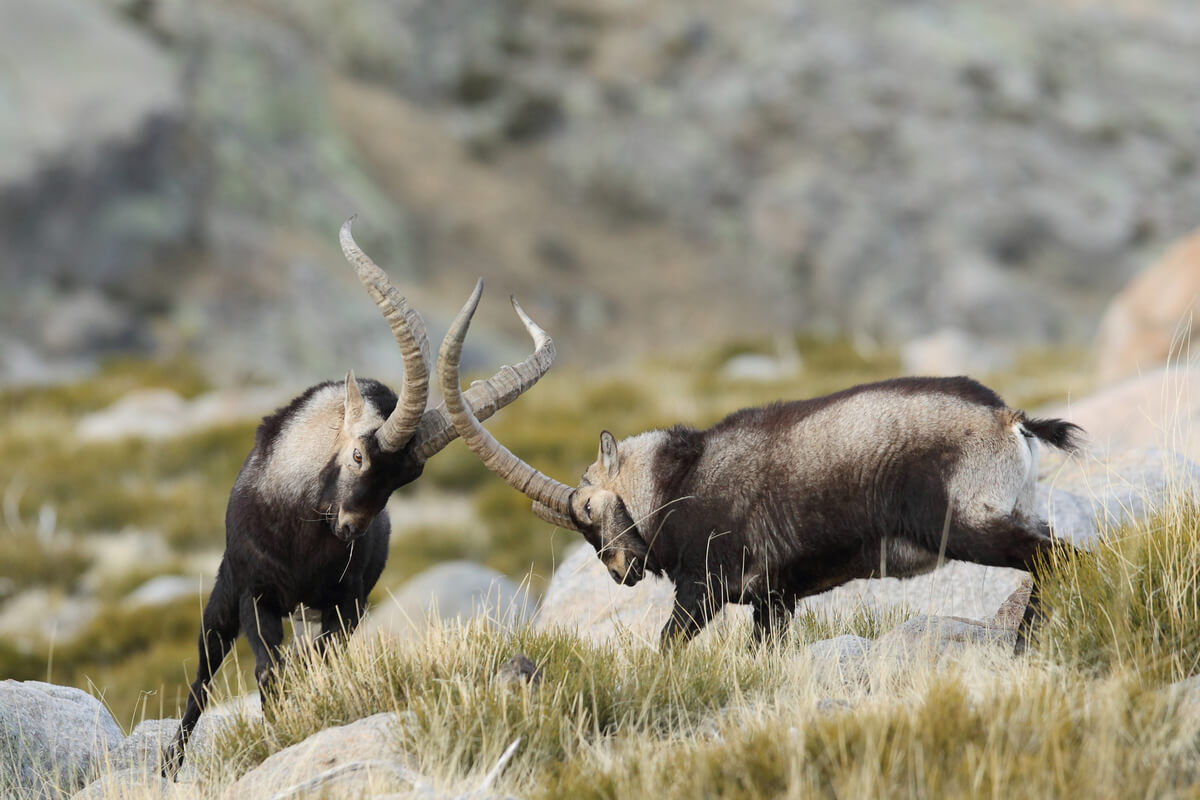Differences Between Viviparous Animals and Mammals


Written and verified by the biologist Cesar Paul Gonzalez Gonzalez
Animals develop various adaptive characteristics to cope with their environment. Among the most important of these is viviparity, a reproductive strategy in viviparous animals characterized by giving birth to live young without the need for an egg as an intermediate formation. However, this trait doesn’t represent a taxonomic category nor does it serve to classify species.
On the other hand, mammals are part of a taxonomic group that exhibits common characteristics and can be either viviparous or oviparous. This idea may cause quite a bit of confusion, because, at first glance, mammals seem to be the same as viviparous animals, but there are clear differences between the two. Read on and learn how to recognize each of them.
What’s a mammal?
Mammals, as we said earlier, are actually a taxonomic class – the class Mammalia – which groups living beings that meet the following characteristics:
- They’re homeotherms. Mammals can regulate their body heat due to their high metabolic rate. Therefore, they’re able to colonize freezing environments at sub-zero temperatures.
- They have three bones in their ears. Hammer, anvil and stirrup (with the exception of species such as the platypus and echidna).
- They have hair in at least one stage of their life. Even marine mammals have hair during embryonic development.
- They have mammary glands. Actually, these structures are sweat glands modified to secrete milk. This characteristic is the flagship within the group and the reason why all representatives of the taxon are called mammals.
This group is monophyletic, meaning that all species within it have the same common ancestor. However, here we find very diverse living beings that live both on land and in water. Their locomotor abilities make them capable of swimming, jumping, flying, running and crawling.
In summary, mammals are capable of colonizing almost any habitat and demonstrate different traits depending on the species being analyzed.

Types of mammals
The great diversity of mammals allows for novel and distinctive life strategies to occur in many of the species. Using this approach, they can be divided into the following three subgroups:
- Monotremes: These are living beings that maintain ancestral characteristics similar to those of reptiles. The most representative is the presence of the cloaca, that is, the “exit” orifice of the digestive, urinary and reproductive tracts.
- Marsupials: These are very similar to placentals, with the difference being that their embryonic development in the uterus is very short. For this reason, their mammary glands are provided in a kind of pouch, as the offspring will finish developing there while they drink their mother’s milk. This sac-like membrane is called the marsupium and is the reason why they’re called marsupials.
- Placentary: The vast majority of mammals belong to this subgroup. This subgroup includes all the species that develop entirely inside their mother’s uterus. For this purpose, a placental membrane is generated that nourishes the baby in the mother’s womb.
What is viviparity?
Viviparity is a reproductive strategy characterized by giving birth to live young. This means that the entire development of the neonate takes place inside the mother. As mentioned above, this term is used to point out a trait of the species, but not to classify it taxonomically.
Apart from viviparity, living beings can employ two other reproductive strategies. We’ll now summarize both of them:
- Oviparity: This is characterized by the production of eggs. The embryo develops outside the mother’s body, but inside an egg that provides it with all the nutrients it needs. This allows a single female to produce more offspring in each reproductive event, since she doesn’t have to store the fetuses in her body.
- Ovoviviparity: This is an intermediate point between oviparity and viviparity. In this strategy, an egg is produced and retained inside the mother, but is released just at the moment of hatching. Thus, the offspring is born (in appearance) like viviparous animals.
Each of the above strategies confer certain evolutionary advantages to species. This means that every animal “chooses” the one that gives it the best results to be successful in its environment. However, these traits aren’t specific to a single taxonomic group.
Are there differences between mammals and viviparous animals?
Mammals belong to a taxonomic group that shares certain characteristics in common. On the other hand, viviparity is a trait that any species can have (or not), no matter which evolutionary group it belongs to. These terms aren’t synonymous, and, according to biological definition, are completely different.
The confusion may be due to the fact that most mammals are viviparous – however, there are some that aren’t. For example, the platypus, which is a monotreme, produces eggs. This makes it erroneous to equate the two concepts or use them as synonyms.
Viviparous animals can come from different taxonomic groups such as reptiles, mammals, amphibians or fish. There are great differences between them and not all members of each group have this characteristic. For this reason, this term is only used to define the type of reproductive strategy of a species.
Some reptiles, such as certain snakes, are completely viviparous even though they aren’t included in the mammalian group.

As you can see, mammals and viviparous animals are animal groups with great differences between them, and only the former represents a valid taxonomic level. Note that this doesn’t mean that it’s wrong to use either term, but rather that you must recognize which group you’re talking about in order to select the appropriate concept.
Animals develop various adaptive characteristics to cope with their environment. Among the most important of these is viviparity, a reproductive strategy in viviparous animals characterized by giving birth to live young without the need for an egg as an intermediate formation. However, this trait doesn’t represent a taxonomic category nor does it serve to classify species.
On the other hand, mammals are part of a taxonomic group that exhibits common characteristics and can be either viviparous or oviparous. This idea may cause quite a bit of confusion, because, at first glance, mammals seem to be the same as viviparous animals, but there are clear differences between the two. Read on and learn how to recognize each of them.
What’s a mammal?
Mammals, as we said earlier, are actually a taxonomic class – the class Mammalia – which groups living beings that meet the following characteristics:
- They’re homeotherms. Mammals can regulate their body heat due to their high metabolic rate. Therefore, they’re able to colonize freezing environments at sub-zero temperatures.
- They have three bones in their ears. Hammer, anvil and stirrup (with the exception of species such as the platypus and echidna).
- They have hair in at least one stage of their life. Even marine mammals have hair during embryonic development.
- They have mammary glands. Actually, these structures are sweat glands modified to secrete milk. This characteristic is the flagship within the group and the reason why all representatives of the taxon are called mammals.
This group is monophyletic, meaning that all species within it have the same common ancestor. However, here we find very diverse living beings that live both on land and in water. Their locomotor abilities make them capable of swimming, jumping, flying, running and crawling.
In summary, mammals are capable of colonizing almost any habitat and demonstrate different traits depending on the species being analyzed.

Types of mammals
The great diversity of mammals allows for novel and distinctive life strategies to occur in many of the species. Using this approach, they can be divided into the following three subgroups:
- Monotremes: These are living beings that maintain ancestral characteristics similar to those of reptiles. The most representative is the presence of the cloaca, that is, the “exit” orifice of the digestive, urinary and reproductive tracts.
- Marsupials: These are very similar to placentals, with the difference being that their embryonic development in the uterus is very short. For this reason, their mammary glands are provided in a kind of pouch, as the offspring will finish developing there while they drink their mother’s milk. This sac-like membrane is called the marsupium and is the reason why they’re called marsupials.
- Placentary: The vast majority of mammals belong to this subgroup. This subgroup includes all the species that develop entirely inside their mother’s uterus. For this purpose, a placental membrane is generated that nourishes the baby in the mother’s womb.
What is viviparity?
Viviparity is a reproductive strategy characterized by giving birth to live young. This means that the entire development of the neonate takes place inside the mother. As mentioned above, this term is used to point out a trait of the species, but not to classify it taxonomically.
Apart from viviparity, living beings can employ two other reproductive strategies. We’ll now summarize both of them:
- Oviparity: This is characterized by the production of eggs. The embryo develops outside the mother’s body, but inside an egg that provides it with all the nutrients it needs. This allows a single female to produce more offspring in each reproductive event, since she doesn’t have to store the fetuses in her body.
- Ovoviviparity: This is an intermediate point between oviparity and viviparity. In this strategy, an egg is produced and retained inside the mother, but is released just at the moment of hatching. Thus, the offspring is born (in appearance) like viviparous animals.
Each of the above strategies confer certain evolutionary advantages to species. This means that every animal “chooses” the one that gives it the best results to be successful in its environment. However, these traits aren’t specific to a single taxonomic group.
Are there differences between mammals and viviparous animals?
Mammals belong to a taxonomic group that shares certain characteristics in common. On the other hand, viviparity is a trait that any species can have (or not), no matter which evolutionary group it belongs to. These terms aren’t synonymous, and, according to biological definition, are completely different.
The confusion may be due to the fact that most mammals are viviparous – however, there are some that aren’t. For example, the platypus, which is a monotreme, produces eggs. This makes it erroneous to equate the two concepts or use them as synonyms.
Viviparous animals can come from different taxonomic groups such as reptiles, mammals, amphibians or fish. There are great differences between them and not all members of each group have this characteristic. For this reason, this term is only used to define the type of reproductive strategy of a species.
Some reptiles, such as certain snakes, are completely viviparous even though they aren’t included in the mammalian group.

As you can see, mammals and viviparous animals are animal groups with great differences between them, and only the former represents a valid taxonomic level. Note that this doesn’t mean that it’s wrong to use either term, but rather that you must recognize which group you’re talking about in order to select the appropriate concept.
All cited sources were thoroughly reviewed by our team to ensure their quality, reliability, currency, and validity. The bibliography of this article was considered reliable and of academic or scientific accuracy.
- Chapman, A. D. (2009). Numbers of living species in Australia and the world. Australian Goverment.
- Blackbum, D. G. (1999). Viviparity and oviparity: evolution and reproductive strategies.
- Lodé, T. (2012). Oviparity or viviparity? That is the question…. Reproductive biology, 12(3), 259-264.
- Abba, A. (2018) El ornitorrinco. Serie Moradores del Museo. Facultad de Ciencias Naturales y Museo (UNLP).
This text is provided for informational purposes only and does not replace consultation with a professional. If in doubt, consult your specialist.








